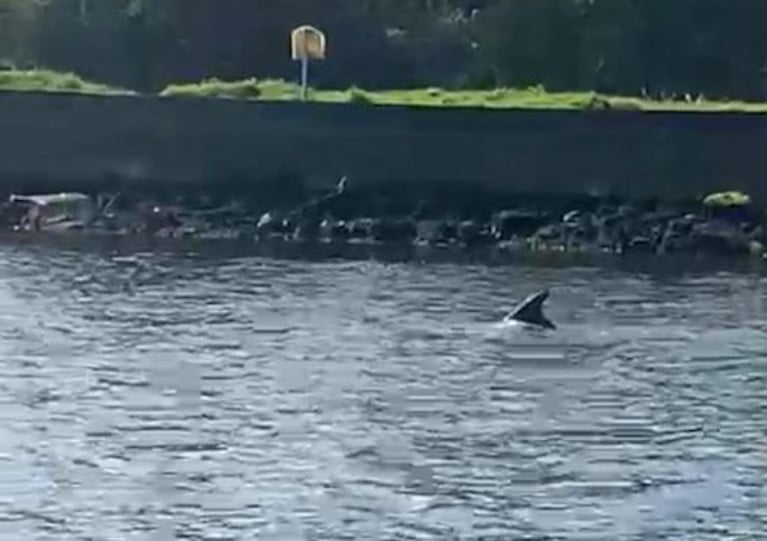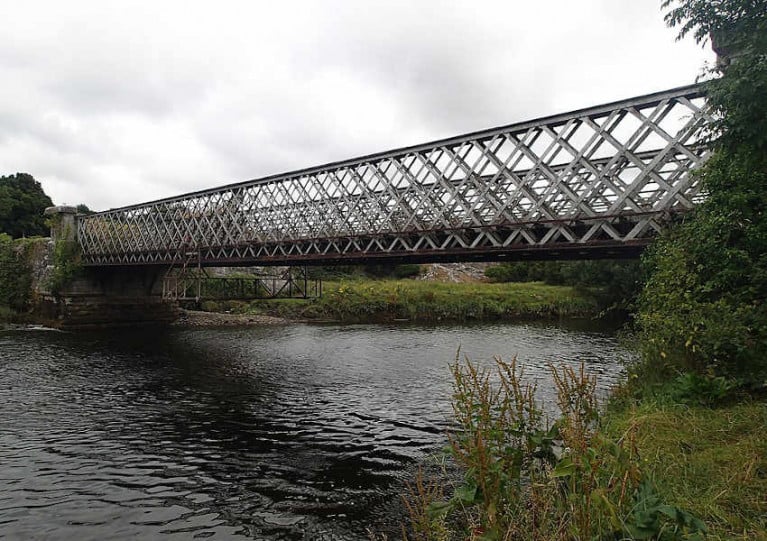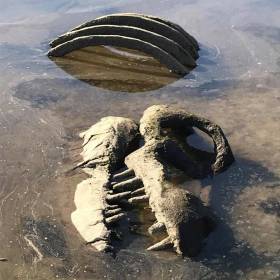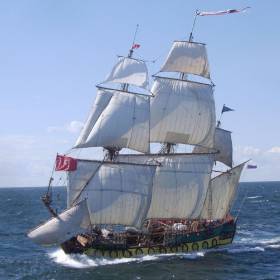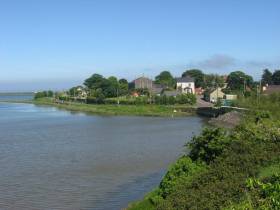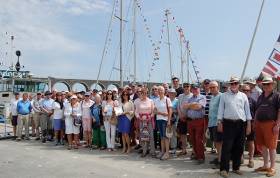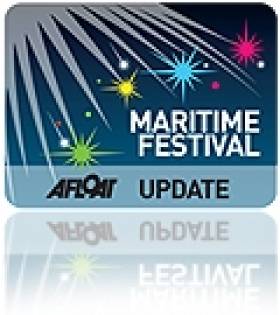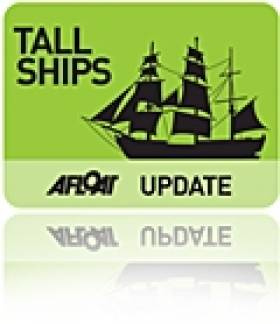Displaying items by tag: Drogheda
Drogheda Coast Guard Seeks New Volunteers
The Drogheda unit of the Irish Coast Guard is currently recruiting for new volunteers to join the Co Louth search and rescue team.
Based at Horse Lane in Drogheda, the emergency service provides boat- and land-based search and rescue response 24 hours a day, 365 days a year.
New recruits will be inducted and trained over a 12-month probationary period, with ongoing accredited training in both land, sea and boat SAR capabilities.
Prospective candidates must have a clean driver’s licence and a good level of physical fitness, as well as live within 10 minutes of the coastguard station, and must commit to weekly training as well as have the flexibility to respond to emergency taskings at any time of day or year.
For more details, see Drogheda Coast Guard’s Facebook page HERE.
Inver Colpa Rowing Club Donate Skipathon Proceeds to Drogheda Women’s and Children’s Refuge
On Saturday 23rd July 2022, Inver Colpa Coastal Rowing Club hosted a 12 Hour Charity Skipathon in Scotch Hall Shopping Centre to raise much-needed funds for both Drogheda Women’s and Children’s Refuge Centre and Inver Colpa Coastal Rowing Club.
The club were delighted to meet again last Saturday in Scotch Hall to present the Drogheda Women’s and Children’s Refuge Centre with a cheque for €2,655.
Club Secretary Glenda Murphy stated:
‘We are thrilled with the amount that we have raised both for the club and for such an important charity like the Drogheda Women’s and Children’s Refuge Centre. We really have to thank all the skippers for their dedication and determination on the day and in their training beforehand, along with Sean Kilroy Fitness & St. Nicholas G.F.C., especially chairman Dessie McDonald, for all their help! We would also like to thank Scotch Hall for hosting the Skipathon, along with everyone who donated, Gillian Marry and Lisa Devlin for the food and Brian Millan for the leg rubs during what was a real test of endurance for our skippers’.
It’s an exciting time for the club as they train for two upcoming races in Skerries and Islandmagee over the next few weeks. Ongoing thanks as always is due to the club’s sponsors - Flo Gas, KC Shipping, EBS Bank, Premium Pellets and helpmypension.ie
Dolphin in River Boyne Excites Drogheda Locals
The Irish Independent covers the excitement among the denizens of Drogheda after a dolphin swimming up the River Boyne paid an unexpected visit to the town.
Reports of a dog in the water yesterday morning (Thursday 22 April) turned out to be wide of the mark when Boyne Fishermen Rescue and Recovery encountered the “medium-sized dolphin” in the River Boyne at the Upper Mell slipway, just east of the town centre and some 7km from the open sea.
The Irish Whale and Dolphin Group says the marine wildlife is likely to be a bottlenose and called for the public to contact it with any images or reports of further sighings.
While there is no immediate cause for concern, dolphins are saltwater animals and can develop serious kidney and skin problems with prolonged exposure to freshwater environments.
Man Dies In Tragic Fishing Accident On River Boyne
Independent.ie reports that a man has died in an incident while fishing on the River Boyne near Townley Hall, outside Drogheda yesterday afternoon, Saturday 27 June.
It’s understood that a man in his 30s was taken from the river two hours after he was reported in difficulty and later pronounced dead in what is being regarded as “a tragic accident”.
Mystery Of ‘Dinosaur Bones’ Found In River Boyne
Drogheda Coast Guard had a prehistoric mystery on their hands earlier this week with what the station is calling “probably the most unusual tasking we ever had or ever will have”.
The coastguard team were tasked on Tuesday (26 February) after an emergency call reporting ‘dinosaur bones’ in the River Boyne close to Drogheda town centre.
And indeed when they arrived the volunteers discovered what appeared to be the skeletal remains of a Tyrannosaurus rex half-submerged in the mud.
But on closer inspection, the bones were revealed to be “a very impressive imitation”.
Drogheda Coast Guard officer in charge Dermot McConnoran told TheJournal.ie that the plaster-cast bones were covered in silt suggesting they’d been in the river for some time.
Further research has turned up images of the same skeleton “in a less river-worn state” from a little over a year ago. It’s not yet known who is responsible for its creation.
Russian Tall Ship 'Shtandart' Among a New Fleet Visiting Drogheda Port for the Irish Maritime Festival
Drogheda Port's Captain Martin Donnelly have invited a wonderful new fleet of ships to visit Drogheda for the Irish Maritime Festival 2017 on 10-11th June.
“The visiting ships are the focal point of The Irish Maritime Festival and it is always wonderful to see people of all ages climbing aboard to explore these magnificent vessels. It’s so important that we offer a selection of ships each year to interest and excite our audience and this is our biggest offering of Tall Ships yet.” explains Capt. Donnelly, Harbourmaster of Drogheda Port.
He was speaking this week as he unveiled the line-up of ships visiting Drogheda this year.
“We’re delighted to welcome the Brian Boru, a sail training vessel based in Waterford. Drogheda’s first crew of sail trainees will arrive at the end of their voyage on Friday while the second crew will depart Drogheda on Monday.”
Perhaps the most impressing of all the ships sailing into Drogheda this summer will be the “Shtandart”. Commissioned by Tsar Peter I of Russia in 1703, the modern day “Shtandart” is an exact replica. Built in 1999, this magnificent 128m long vessel carries 10 officers and 30 trainees. The elegant masts will play host to the Peter Pan aerial acrobatic show during the Irish Maritime Festival.
He continued “We’ve an unusual new addition to the festival for 2017. Coming into service in 1965, the motor tug “Brocklebank” served for 23 years as a tug assisting cargo ships, passenger liners and naval vessels to their berths. She really has been a workhorse of the maritime industry. Now, in retirement, she resides at Albert Dock as part of the Liverpool Maritime Museum and we’re delighted that she’s making the journey to Drogheda for the festival.”
Captain Donnelly concluded “Others visiting Drogheda for the festival include “La Malouine”, an elegant Polish brigantine, the Danish schooner “Soteria” and the stunning “Phoenix”. “The Earl of Pembroke” a magnificent three-masted sailing ship will also dock at Drogheda Port and play host to the Stowaway Sessions, two intimate music gigs on Friday and Saturday night.”
Keep your eye out for the beautiful tall sailing ship “Maybe”, which was built in 1929, which will make a short appearance with another crew of sail trainees. This year there is a big focus on sail training at the festival with no less than three vessels carrying trainees. A special gathering and presentation is taking place at 6.00pm on Friday 9th June at Millmount Tower. Anyone interested in future voyages is welcome to attend.
Find out more about each of the ships by visiting www.MaritimeFestival.ie/Ships. The Irish Maritime Festival is hosted by Louth County Council and Drogheda Port Company in association with Virgin Media. Find out more by visiting www.MaritimeFestival.ie and follow on Facebook and Twitter for competitions, news and festival updates.
Boyne Boat Capsize Trio ‘Lucky To Be Alive’
#Coastguard - Three people are “extremely lucky to be alive” after their boat upturned on the River Boyne last night (Monday 17 April), as TheJournal.ie reports.
The three casualties rescued east of Mornington, Co Meath were found to be not wearing lifejackets when they were rescued by volunteers from Drogheda Coast Guard.
Clogherhead RNLI also attended the incident, which occurred east of Drogheda Port, after a member of the public raised the alarm around 9.30pm.
“Only for the quick thinking of the caller and the rapid response from all agencies involved were we able to bring this incident to a successful conclusion,” said an Irish Coast Guard statement.
Elsewhere, DublinLive reports on Howth Coast Guard’s rescue of two kayakers stranded at Ireland’s Eye on Saturday afternoon (15 April).
The coastguard volunteers were on exercise when by chance they happened upon the kayaking duo, who had set out with no means to call for help.
Drogheda Port Company welcomed the Irish Cruising Club Rally to Drogheda on the weekend of Saturday 4th June for the first time in 41 years. The club last visited Drogheda in September 1975. The recent promotion and popularity of the river Boyne and the Irish Maritime Festival as key tourist attractions for visiting leisure boats was fundamental in attracting the club back to the Boyneside to have their annual rally.
The club visit consisting of 17 yachts and 60 visitors arrived from all parts of Ireland, north and south and were welcomed into the port on saturday morning on the high tide by the acting port Chairperson Gail McEvoy. The yachts were accommodated on the steampacket quay inside the town port.
Specially designed Drogheda burgees, with the eight pointed star and crescent from the port emblem of 1770, were presented to the captain of each of the visiting yachts as a memento of their visit by acting port chairperson Gail McEvoy, to spread the word to the yachting community that Drogheda is open to leisure tourism.
A welcoming hamper was also put on board each of the visiting yachts with samples of the best of local produce. The port company wishes to acknowledge the generous involvement of Dan Kelly’s Cider, Jack Cody’s Beer, Boyne Valley Foods, East Coast Bakehouse, Clarkes Fresh Fruit and Gerry’s Fresh Food, all playing their part to promote the region through Corporate Social Responsibility initiatives such as this.
The visitors had a full itinerary organised for their stay and enjoyed the historic town with a walking tour arranged through the Old Drogheda Society and finishing with an evening meal in the town centre.
Tom Fitzpatrick Rally Captain thanks Drogheda port for the warm welcome the club received from Drogheda Port and commented on the lovely sail into Drogheda along Boyne which had surpassed everyone’s expectations. He presented a copy of the club burgee and annual from 1975 commemorating the last time the club visited.
Paul Fleming Drogheda Port CEO in welcoming the visitors agreed with the rally Captain that the most attractive way to arriving to Drogheda is on the Boyne on a sunny day, a pleasure few people get to experience, but thankfully this is changing. He also thanked the local food producers who all contributed to extending a local welcome which will be remembered.
The club was founded in 1929 and initially arranged offshore races as well as cruising activities and into the 1960s was organising the Irish Admiral’s Cup teams for their biennial foray to Cowes. Since the 1970s the focus of the club has been to promote cruising under sail and to provide publications and services for members and for the cruising community.
#droghedamaritime – The third annual Irish Maritime Festival took over Drogheda last weekend. The flotilla of ships sailed into Drogheda on Friday afternoon and from that moment on the sun shone. The Festival, hosted by Louth County Council and Drogheda Port Company, saw over 40,000 visitors come through the gates and enjoy all the fun.
"The 2015 Irish Maritime Festival was bigger and better than ever before. Our aim is to grow the Festival to become recognised on the national calendar of events and this year moved us ever closer to that aim." explained Mary T. Daly of Louth County Council "Working with Drogheda Port Company, we bring the structure and the organisation but the local community bring the personality, fun and action. It was just brilliant to see so many community groups involved in making the Festival such a success."
Speaking about the action on, in and above the water Chair of Drogheda Port Company Denis Moynihan continued "The Festival featured a number of epic battles including the Boyne Swim, The Boyne Boat Race, Howth-Drogheda Yacht Race, the Battle Over The Boyne Tug of War and The East Coast Chowder Championship. We were delighted to welcome athletes and vessels from all over the country to compete here at the Festival. The victories were hard won and well done to one and all."
All weekend the kids laughed, the pirates battled, the chefs cooked and the huge ferris wheel spun.
Karen Healy, event organiser continued "There was a wonderful atmosphere all weekend. We loved seeing so many visitors from near and far enjoying all that Drogheda has to offer. The music stages were a huge hit with bands, singers and dancers from all over the North East creating a soundtrack for the Festival. The beautiful ships were the focal point and, as always, the pirates brought action and adventure to the water."
The Irish Maritime Festival, in association with Maxol, is a massive undertaking but the outcome of all the plans was a fun, lively festival that was enjoyed by so many. "The support of sponsors, both local and national, is of vital importance in helping us grow The Irish Maritime Festival. We are so grateful to sponsors, media and event partners who helped us to deliver this huge event. And of course, the event wouldn't exist without the support of the public who make all the months of planning and hard work so worthwhile. Roll on The Irish Maritime Festival 2016 ..." concluded Louth County Council's Mary T. Daly.
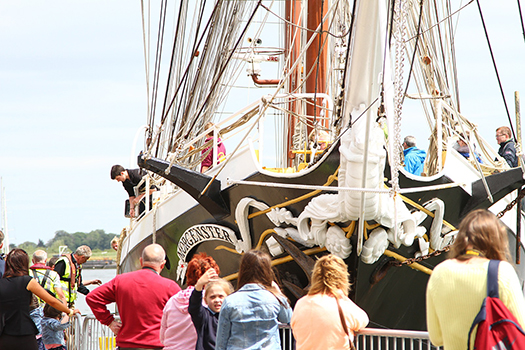
Arrival of the Morgenster
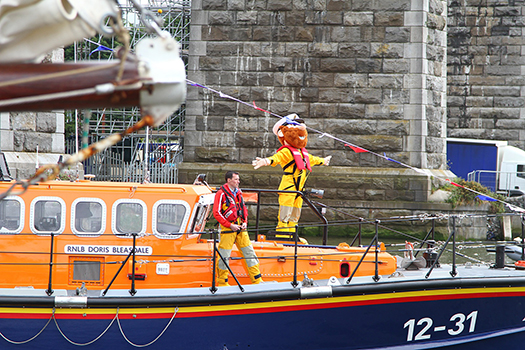
Arrival of the RNLI
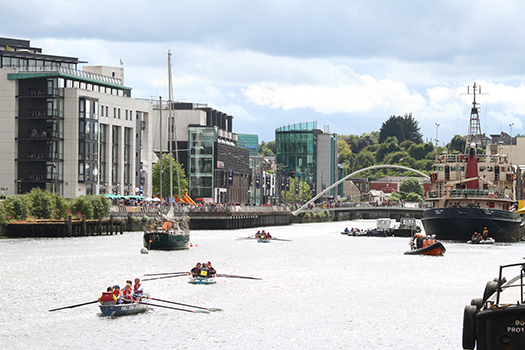
Boats on the Boyne
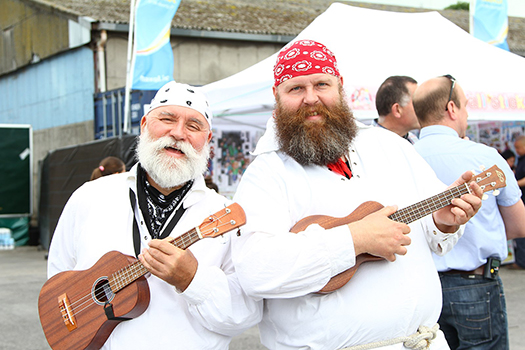
Dueting Pirates
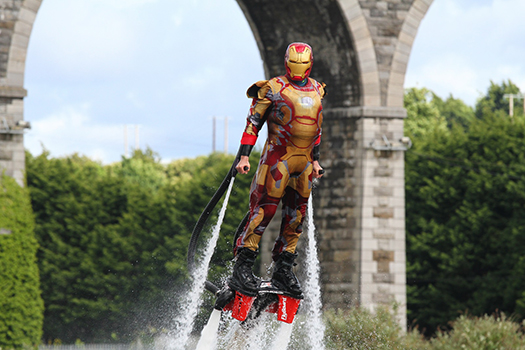
Iron Man in Action
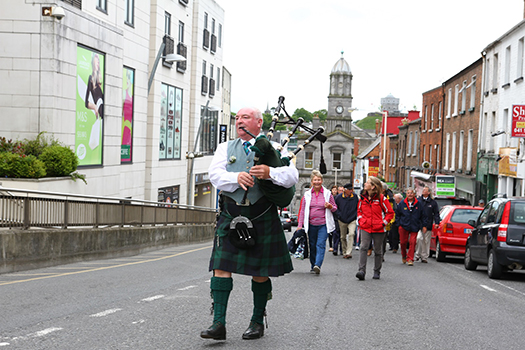
Piper leads Sailors to Maritime Blessing in St. Peters
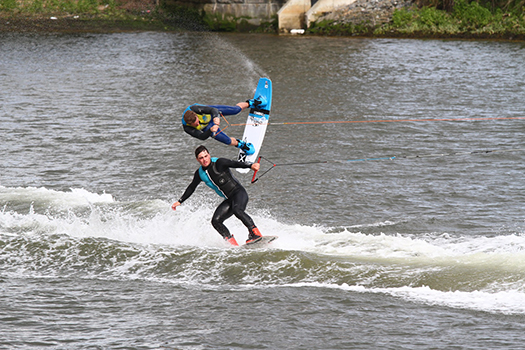
Wakeboarders
The Tall Ships Are Coming to Drogheda
#tallships – The countdown to The Irish Maritime Festival is well and truly on. The ships have set sail from their respective home ports and are fast approaching Drogheda for the Festival from 19-21st June.
In association with Maxol, The Irish Maritime Festival is one of the largest festivals in the North East and attracts visitors from Dublin, Belfast and all across the country. Situated in the historic port of Drogheda, the event is staged by Louth County Council and Drogheda Port Company.
The ships will arrive in a parade of sail up the River Boyne on Friday 19th June beginning at 1.30pm and everyone is welcome to be there. "It is such a wonderful sight to see these magnificent vessels sailing up the river. We invite and encourage everyone to be there. The parade of sail and opening event on Friday is free to attend and children and families are particularly welcome." explained Festival Organiser Mary T. Daly of Louth County Council
This family friendly festival features a huge range of off and on shore activities. The off-shore schedule includes over 250 swimmers competing in the challenging Boyne Swim, a 2.7km long swim finishing in front of cheering audiences. Check out the fleet of vintage lifeboats courtesy of the RNLI and learn about their adventures at sea. Board the beautiful classic ships or marvel at the 100ft long Class A Tall Ship "The Morgenster", so tall that it won't even fit under Drogheda's iconic viaduct. Watch out for the Boyne Regatta and the Howth to Drogheda yacht race.
Seasonal favourites such as the Pirate Battles and Extreme Sports displays will also return to the River Boyne as part of the 2015 Irish Maritime Festival.
Another new challenge this year is the heroic "Battle Across the Boyne" Tug of War taking place on Sunday at noon at the DeLacy Bridge. Teams from the near side and the far side will compete for glory.
On-shore there is lots to do and see. "The Irish Maritime Festival truly allows the local community here in Drogheda and the Boyne Valley to shine" Mary T. Daly continued. "The Festival is made up of so many brilliant community groups and businesses who bring so much to the Festival and are helping to grow it into a truly national event. There will be sand castle competitions, adults and kids cookery demos, maritime themed walking tours, artisan food producers, skills displays by the Scouts and much more. Two live music stages will be going all weekend with singer songwriters and bands from all over the North East. Chill out in the pop up cinema and catch up on some maritime themed family movies. Visit the aquarium. Meet the whale and dolphin experts and see their life sized models. Take part in the art competition in the Art and Photography zone. Compete for the chance to be crowned the East Coast Chowder Champion. And there's more, much more to see and do."
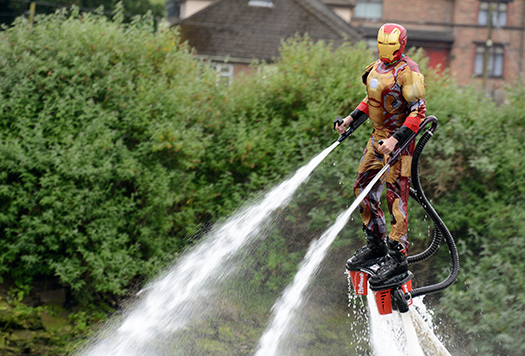
See the Iron Man in Drogheda
Car lovers won't want to miss the 5th Annual Drogheda Motor Show also taking place at The Irish Maritime Festival. Shiny new cars with beautiful interiors and great sales promotions are the order of the day at the Motor Show. Watch out for the "Design a Car" challenge. This competition is a collaboration between local primary schools, local motor dealers and the team at Drogheda Men's Sheds and the results promise to be some pretty innovative car designs.
It's not too late to volunteer to be part of the Festival. Mary continued "We are expecting 40,000+ visitors to the Festival over the weekend so we are delighted to have such a brilliant team of volunteers on board. Become part of the Festival Volunteer team by visiting www.maritimefestival.ie/volunteer, complete your details and one of the volunteer co-ordinators will be in touch."
Tickets for all this family fun are surprisingly affordable at just €5.00 for 1 adult and up to 2 children or €10 for a family ticket of 2 adults and up to 4 children. Tickets are available at the gate or avail of a 20% saving when you book online at www.MaritimeFestival.ie.
"The long range weather forecast is good and the ships are on their way. We've lots of fun, family friendly activities planned for everyone and we can't wait to welcome you all. Ahoy there – see you at the Irish Maritime Festival!" concluded Mary T. Daly.


























